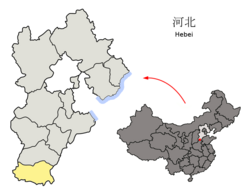Handan
|
Handan 邯郸市 |
|
|---|---|
| Prefecture-level city | |
 |
|
 Location of Handan City jurisdiction in Hebei |
|
| Location of the city centre in Hebei | |
| Coordinates: 36°36′N 114°29′E / 36.600°N 114.483°E | |
| Country | People's Republic of China |
| Province | Hebei |
| Area | |
| • Prefecture-level city | 12,068 km2 (4,659 sq mi) |
| • Urban | 142 km2 (55 sq mi) |
| • Metro | 2,466 km2 (952 sq mi) |
| Population (2010 census) | |
| • Prefecture-level city | 9,174,683 |
| • Density | 760/km2 (2,000/sq mi) |
| • Urban | 941,427 |
| • Metro | 2,845,790 |
| • Metro density | 1,200/km2 (3,000/sq mi) |
| Time zone | China Standard (UTC+8) |
| Licence plate prefixes | 冀D |
| Website | hd |
| Handan | |||||||||||||||||||||||||

"Handan" in Simplified (top) and Traditional (bottom) Chinese characters
|
|||||||||||||||||||||||||
| Traditional Chinese | 邯鄲 | ||||||||||||||||||||||||
|---|---|---|---|---|---|---|---|---|---|---|---|---|---|---|---|---|---|---|---|---|---|---|---|---|---|
| Simplified Chinese | 邯郸 | ||||||||||||||||||||||||
|
|||||||||||||||||||||||||
| Transcriptions | |
|---|---|
| Standard Mandarin | |
| Hanyu Pinyin | Hándān |
| Wade–Giles | Han2-tan1 |
| IPA | [xǎntán] |
| Yue: Cantonese | |
| Yale Romanization | Hòhn-dāan |
| Jyutping | Hon4-daan1 |
| Southern Min | |
| Hokkien POJ | Hân-tan |
| Old Chinese | |
| Baxter-Sagart | *[g]ˤa[n] tˤa[r] |
Handan (Chinese: 邯郸) is a prefecture-level city located in the southwestern part of Hebei province, China. It borders Xingtai on the north, and the provinces of Shanxi on the west, Henan on the south and Shandong on the east. At the 2010 census, its population was 9,174,683 inhabitants whom 2,845,790 lived in the built-up (or metro) area made of 3 urban districts, Handan and Yangyan counties, and Shahe City in Xintai municipality, largely being conurbated now.
Handan, whose name has not changed in its entire history (unlike most other Chinese cities), was the capital of the State of Zhao during the Warring States period (475−221 BCE), after the capital moved from Zhongmu. King Wuling of Zhao turned Zhao into one of the Qin state's most stalwart foes, pioneering the use of walls to secure new frontiers (which would inspire the eventual construction of the Great Wall of China). The city was conquered by the State of Qin after the virtual annexation of Zhao by Qin except for the Dai Commandery. The first emperor of China, Qin Shi Huang was born in Handan, the child of a statesman from the state of Qin and after successfully conquering Zhao he ordered all enemies of his mother to be buried alive. The conquest of Zhao, particularly the Qin siege of Handan, is featured extensively in Chen Kaige's classic film, The Emperor and the Assassin.
Handan was still regarded as a cultural and commercial centre during the Western and Eastern Han dynasties (206 BCE−220 CE). It slowly declined, perhaps because of the numerous battles that ravaged northern China following the Han Dynasty, but maintained a reputation for its fine Cizhou ware well into the Qing dynasty (1644–1911). It was also the birthplace in the 19th century of Yang-style t'ai chi ch'uan, one of the five major schools of tai chi in China.
...
Wikipedia

